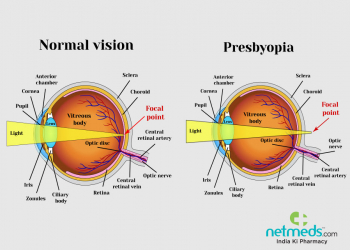Presbyopia is a very common eye disorder where people have difficulty focusing on objects that are nearby, as they grow older, unlike in myopia, where things far away cannot be viewed clearly. Also Read: Myopia: Causes, Symptoms And Treatment It usually begins in middle-aged individuals post the age of 40, with eyesight declining further as they complete 60 years of age. As light from any particle enters the eye, it initially goes past the cornea and then pupil. The iris, being the coloured circular organelle in the eye, regulates the widening and closing of the pupils, to modify the intensity of light that is allowed to pass through it. Once the light goes past the pupils, it falls on the eye lens. At a younger age, the lens is in a very fit condition, bending the light rays appropriately, so as to present a clear image of the object on the retina. However, with age, the flexibility of the eye lens declines, hence making it difficult to bend and form an accurate image of the object on the retina. This eye defect due to ageing can be rectified by means of correction glasses or even surgery. Once indications of presbyopia are noticed in any individual, it is advised to consult with an eye doctor, to ensure proper diagnosis and treatment. presbyopia Causes Of Presbyopia At a young age, the eye lens is very healthy and quite flexible in nature. It can effortlessly change its shape, by using a ring of muscles present around it, to properly focus the light rays from any object, on the retina, so all masses can be viewed clearly. However, as people grow older and cross the age of 40, the eye lens starts to become stiff and hardened mass forms on it. As a result, the lens lose their flexibility and constrict when trying to focus on things that are nearby, in contrast to diabetic macular edema where the macula and other portions of the retina are damaged. Hence vision becomes blurred, which is the onset of presbyopia and eye lens cannot accurately focus light from closer objects on the retina. Symptoms The characteristic signs of presbyopia include the following: Excess strain in the eyes post reading a book Throbbing headaches after attempting to view objects nearby Feeling tired and exhausted after knitting or working with things in close focus Requiring much brighter light to view things that are nearby Inability to read the small print as in newspapers in an accurate manner Blurred vision, such as in anisocoria Frequent squinting of eyes while trying to focus on close objects Diagnosis The eye specialist, also known as an ophthalmologist, performs a complete eye exam as well as a refraction assessment, to determine the kind of eye defect the patient is suffering from. A refraction assessment is one where the medical expert utilises many instruments and lab lenses, to determine the patient’s viewing ability of nearby and farther objects. This helps to correctly identify if the person has myopia, presbyopia or astigmatism. Also Read: Astigmatism: Causes, Symptoms And Treatment The healthcare provider puts in a few drops into the eyes, to carry out an eye exam. This helps to dilate the pupils so that the doctor can easily view the interior portion of the eyes and make an exact diagnosis as to which type of eye defect the patient has. Treatment Treatment for presbyopia is mainly to improve the ease of viewing nearby objects. The doctor prescribes either eyeglasses or contact lenses, with a corrective power, that will assist the patient in clearly focusing on close-up things. In case presbyopia is advanced to a greater extent, with entirely blurred vision while viewing nearby particles, then refractive eye surgery is performed. This alters the shape of the cornea, to help the person with presbyopia easily focus on objects that are close.

Presbyopia: Causes, Symptoms and Treatment